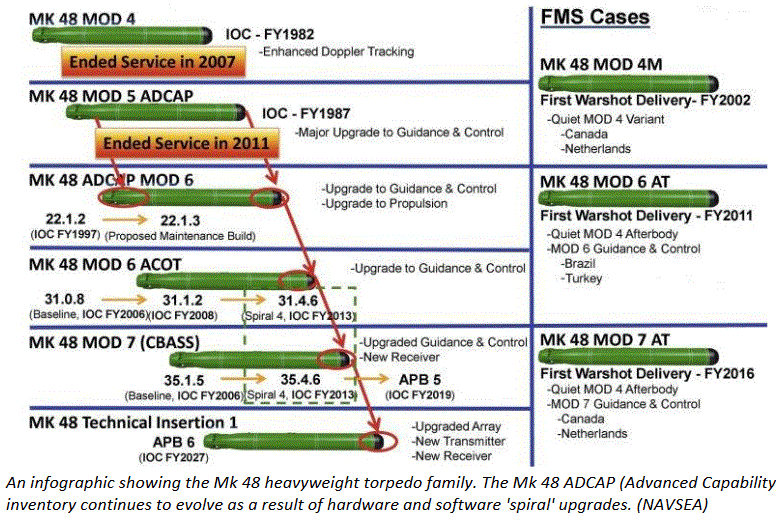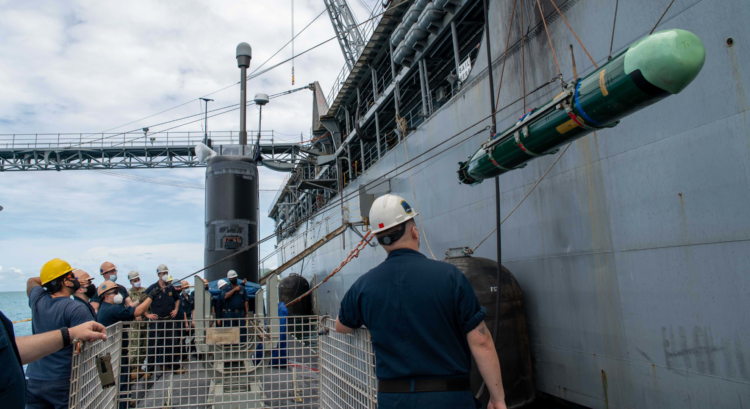American technology contractor Science Applications International Corporation (SAIC) received an additional $102.5 million contract to continue supporting the US Navy‘s Mk-48 Mod 7 Heavyweight Torpedo program.
In a press release, the SAIC said this is a modification to a previously awarded $1.1 billion production contract, which also includes sustaining the company’s quest to develop, test, manufacture, and deliver the Mk-48 Mod 7 Torpedo Afterbody Tailcones and Mk-29 Mod 0 Warshot Fuel Tanks for the Navy and signed foreign partners.
“SAIC has a long history of supporting the US Navy, notably our work providing the dominant undersea weapons it requires,” said Bob Genter, SAIC’s Defense and Civilian Sector President, in a press release. “We are honored by the Navy’s confidence in SAIC, and proud to expand our support of the Mk-48 program.”
A submarine-launched torpedo, the Mk-48 is made to counter surface and sub-surface threats in deep and shallow waters. It is the only anti-submarine and anti-surface ship weapon used by Navy submarines.
According to its fact sheet, the heavyweight torpedo program kickstarted in the late 1960s to keep pace with the Soviet Union’s advancing underwater technology. Its first version became operational in 1972, replacing torpedoes Mk-37, Mk-14, and Mk-16 as the primary lethal munition of the US Navy submarines, including Ohio-class ballistic missile subs and Seawolf-, Los Angeles-, Virginia-class attack subs, and a few other international Navies.

The heavyweight torpedo remains in service today with several modifications to its abilities throughout the years. Each weighs 3,744 pounds (1,700 kilograms) and measures 21 inches (53 centimeters) in diameter. Using an acoustic-homing sonar, a liquid-propellant engine drives it and engages targets at up to 50 knots (58 miles per hour).
In 2006, the Mod 7 variant achieved its initial operational capability. This software enhances “the torpedo’s ability to detect and classify enemy submarine and surface ships.”
By 2018, the service began another set of modifications, now equipped with Advanced Processor Build (APB) 5 software that bolsters the torpedo’s Anti-Submarine Warfare (ASW) performance.
According to the assessment of the Initial Operational Test and Evaluation (IOT&E) in 2021, although the Mk-48 with APB 5 has proven operationally “effective and suitable,” it is nonetheless “vulnerable in a cyber-contested environment.”
The Navy launched a follow-up enhancement, APB 5+, a year before the 2021 IOT&E. This variant sought “to transfer targeting functions from the submarine combat system to the torpedo itself,” offering operators a better interface and faster data exchange rates.

Likewise, for its guidance system, the Mod 7 variant currently utilizes a Common Broadband Advanced Sonar System (CBASS), which optimizes the torpedo’s deep and littoral waters and its counter-countermeasures against enemy attacks. Moreover, this variant results from a Joint Development program with the Royal Australian Navy.
The Mk-48 heavyweight torpedo is currently in service with Australia, Brazil, Canada, the Netherlands, and the United States, with Taiwan as a prospective future operator.
Torpedoes become essential as tensions build in Asia-Pacific
Tensions building in the Asia-Pacific region caused by China’s aggressive expansionist ambitions have prompted the US and its regional allies to ramp up torpedo enhancement-related programs.
SAIC previously received separate funding to “exercise options for the production, spares, production support material, engineering support, and hardware repair of components for Mk-48.”
The Navy also awarded Lockheed Martin a $16 million contract supporting the heavyweight torpedo efforts, including “engineering and maintenance services at Intermediate Maintenance Activity [in] Pearl Harbor, Hawaii.”
Surrounded by the vast deep blue ocean, countries around the Asia-Pacific invest heavily in naval warfare, which is also the case with China as it attempts to expand in the region, particularly in the East and South China Sea, and its assertive subjugation with the autonomous country of Taiwan.
Beijing, in recent years, has been making rapid progress in its quest to modernize its military, including in its Navy—spending ample funds to construct warships and munitions.
Naval Technology reported in February that China is the top procurer of torpedoes (out of the countries in and around the South China Sea region) so far in fiscal 2023, spending about $49.5 million. This is then followed by Taiwan ($36.3M), South Korea ($19.3M), Japan ($16.8M), and Australia ($16.4M), among many others.
The United States, on the other hand, plans to spend over $151 million for torpedoes in fiscal 2023 alone.
This report, which the Naval Technology derived from the research firm GlobalData, shows the growing demand for underwater warfare systems as a potential future conflict in the region grew increasingly imminent.










COMMENTS
You must become a subscriber or login to view or post comments on this article.